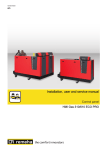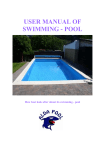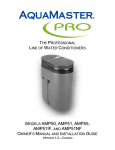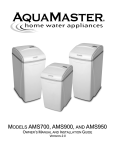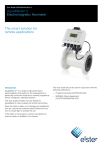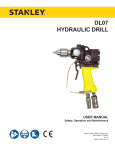Download AquaMaster AMS950 Installation manual
Transcript
AquaMaster™ Installation Manual Use of Instructions Warning. An instruction that draws attention to the risk of injury or death. Note. Clarification of an instruction or additional information. Caution. An instruction that draws attention to the risk of damage to the product, process or surroundings. Information. Further reference for more detailed information or technical details. Although Warning hazards are related to personal injury, and Caution hazards are associated with equipment or property damage, it must be understood that operation of damaged equipment could, under certain operational conditions, result in degraded process system performance leading to personal injury or death. Therefore, comply fully with all Warning and Caution notices. Information in this manual is intended only to assist our customers in the efficient operation of our equipment. Use of this manual for any other purpose is specifically prohibited and its contents are not to be reproduced in full or part without prior approval of the Marketing Communications Department. Health and Safety To ensure that our products are safe and without risk to health, the following points must be noted: 1. The relevant sections of these instructions must be read carefully before proceeding. 2. Warning labels on containers and packages must be observed. 3. Installation, operation, maintenance and servicing must only be carried out by suitably trained personnel and in accordance with the information given. 4. Normal safety precautions must be taken to avoid the possibility of an accident occurring when operating in conditions of high pressure and/or temperature. 5. Chemicals must be stored away from heat, protected from temperature extremes and powders kept dry. Normal safe handling procedures must be used. 6. When disposing of chemicals ensure that no two chemicals are mixed. Safety advice concerning the use of the equipment described in this manual or any relevant hazard data sheets (where applicable) may be obtained from the Company address on the back cover, together with servicing and parts information. © 2002 ABB Water Meters. All rights reserved. CONTENTS 1 INTRODUCTION 1 INTRODUCTION ....................................1 2 MECHANICAL INSTALLATION ............ 2 2.1 Unpacking ....................................... 2 2.2 Installation Conditions ..................... 2 2.3 Mechancial Installation .................... 4 AquaMaster™ includes the family of high performance electromagnetic flow meters for water measurement that normally are supplied as factory configured, calibrated systems. 2.3.1 3 Transmitters ............................ 4 ELECTRICAL INSTALLATION ............. 5 3.1 Grounding ....................................... 5 3.2 Connections .................................... 6 3.2.1 3.2.2 3.2.3 Sensor Terminal Box Connections (Remote Versions only) .......... 6 Environmental Protection ....... 6 Transmitter Connections ......... 7 3.3 Input/Output Connections ............... 10 3.3.1 3.3.2 3.3.3 Frequency Outputs ................. Alarm Interface ....................... MIL Connector Input/Output Connections (Option) .............. MIL Connector Input/Output (Option) - AquaMag™ x10 Pulse Output Compatibility ..... Encoder Output (Option) ................................... Local Computer Connection ............................. Remote Computer Connection ............................. Power Supply Connection ...... Pressure Transducer (Optional) ................................ Environmental Protection ....... 10 10 START-UP AND OPERATION ............. 4.1 Connecting Batteries ...................... 4.2 Start-up ........................................... 4.3 Display Activation ........................... 4.4 Replacing a Battery ........................ 17 17 17 19 19 3.3.4 3.3.5 3.3.6 3.3.7 3.3.8 3.3.9 3.3.10 4 4.4.1 4.4.2 11 Warning. ! Installation and maintenance must only be carried out by suitably trained personnel. ! All relevant sections of this manual must be read before selecting a location. ! Safety requirements of this equipment, any associated equipment and the local environment must be taken into consideration. ! The installation and use of this equipment must be in accordance with relevant national and local standards. 12 12 13 14 15 16 16 Spares Kits ............................. 20 Battery Changing Procedures ............................. 21 APPENDIX - AQUAMASTER BLOCK DIAGRAM ............................................. 23 1 2 MECHANICAL INSTALLATION 2.1 Unpacking Allow room to read display AquaMaster AquaMaster AquaMaster AquaMaster Fig. 2.5 Siting Fig. 2.1 Unpacking 2.2 Installation Conditions >2 x pipe dia. >5 x pipe dia. minimum minimum Caution. Do NOT exceed the maximum working pressure marked on the equipment. Flow Direction Fig. 2.6 Straight Pipe Requirements Fig. 2.7 Fluid Level Fig. 2.2 Spillage 140°F (60°C) Maximum AquaMaster -4°F (-20°C) Minimum 2 Fig. 2.3 Vibration Fig. 2.8 Within Temperature Limits Fig. 2.4 Localized Heat Fig. 2.9 Shade 2 MECHANICAL INSTALLATION... 3 ...2 MECHANICAL INSTALLATION 2.3 Mechanical Installation 2.3.1 Transmitter Installation and wiring access 12" minimum, 18" preferred AquaMaster Transmitter 5.7" (146mm) 4.9" (125mm) 6.7" (170mm) 5.9" (150mm) 7 (176mm) 0.25" (6.5mm) 0.50" (13mm) AquaMaster 6.1 (155mm) 5.5 (140mm) 0.25" (6.5mm) Transmitter Mounting Plate Allowance for cable bend - each side 6" (Standard) 9" (Armored) Fig. 2.18 Transmitter Dimensions 4 3 ELECTRICAL INSTALLATION 3.1 3 ELECTRICAL INSTALLATION... Grounding (Figs. 3.1 to 3.2) Supplied Bonding Cable Bond this end of the meter to the pipeline Insulating Sleeve Insulated connecting (using grounding and Washer wire (not included). ring if required) (not provided) Must be adequately rated to carry cathodic currents. Supplied Bonding Cables Gasket Gasket Grounding Ring Note. 5/8" to 1" threaded end sensors will require a plastic isolation section in the pipe, and a cathodic current bypass wire. Caution. Do NOT ground Cathodically Protected Systems. Fig. 3.2 Pipelines with Cathodic Protection 5 ...3 ELECTRICAL INSTALLATION 3.2 Connections 3.2.1 Sensor Terminal Box Connections (Remote Versions Only) (Remote Versions Only) Fig. 3.6 Potting the Terminal Box 6 Warning. ! Potting materials are toxic — use suitable safety precautions. ! Read the manufacturer’s instructions carefully before preparing the potting material. ! The remote sensor terminal box connections must be potted immediately on completion to prevent the ingress of moisture. ! Check all connections before potting see ELECTRICAL INSTALLATION. ! Do not overfill or allow the potting material to come into contact with “O” rings or grooves. ! Do not let potting material enter conduit, if used. 3 3.2.3 ELECTRICAL INSTALLATION... Transmitter Connections 7 ...3 8 ELECTRICAL INSTALLATION 3 ELECTRICAL INSTALLATION... 9 ...3 ELECTRICAL INSTALLATION 3.3 Input/Output Connections 3.3.1 3.3.2 10 Frequency Outputs - Fig. 3.11 Alarm Interface - Fig. 3.12 3 3.3.3 ELECTRICAL INSTALLATION... MIL connector Input/Output connections (Option) - Fig. 3.13 11 3 ELECTRICAL INSTALLATION... 3.3.6 MIL Connector Input/Output (Option) - AquaMag™ x10 Pulse Ouput Compatibility Where an existing installation has been wired to operate from the x10 outputs of an AquaMag™, the wiring of the AquaMaster™ connector can be altered to suit, as shown in Fig. 3.14. 3.3.5 12 Encoder Ouput (Standard Option AquaMaster Only) - Fig. 3.15 3 3.3.6 ELECTRICAL INSTALLATION... Local Computer Connection - Fig. 3.16 Connected to 9-pin Serial Data socket on PDA or PC via 'Laplink' lead/adaptor AquaMaster Transmitter Original Style ° ABB Part No.WEBC2000 Current Style 9-pin female (direct to PC) Fig. 3.16 Local Computer Connections 13 3 3.3.7 14 ELECTRICAL INSTALLATION... Remote Computer Connection - Fig. 3.17 3 3.3.8 ELECTRICAL INSTALLATION... Power Supply connection - Fig. 3.18 AC or AC/Battery Powered Units Battery Powered Units 15 3 ELECTRICAL INSTALLATION... 3.3.9 Pressure Transducer (Optional AquaMaster S only) Optional pressure transducer cables are available for a range of pressures and cable lengths. Caution. Ensure that only the pressure transducer supplied with the transmitter is used. Use of other pressure transducers will require alteration of the pressure span and zero factors in the transmitter — see Quick Reference Programming guide. Pressure Transducer Connector Fig. 3.19 AquaMaster fitted with OptionalPressure Transducer Connector 3.3.10 Environmental Protection - Sensor Potting 1. Remove lid from transmitter. Fig. 3.20a 2. If fitted, note position of batteries and then remove from battery tray. Fig. 3.20b 16 3 ELECTRICAL INSTALLATION... 3. Remove battery tray by pushing right-most clips towards the left and lifting Fig. 3.20c 4. Check to insure that all required cables are fitted correctly and that either a connector, gland or blanking plug seals all gland holes. Fig. 3.20d 5. Carefully pour potting into termination area, until potting just covers the terminal blocks. To prevent possibility of short circuit, potting compound should cover all terminal screw heads. Fig. 3.20e 6. Re-insert battery tray. Gently press down on the battery tray so that the potting level rises. 7. Leave to stand for 15 minutes to allow potting to gel. 8. If present, refit batteries to original positions and refit lid. Fig. 3.20f 17 4 START-UP AND OPERATION 4 START-UP AND OPERATION... 4.1 Connecting Batteries The AquaMaster has been supplied with one or two batteries, but not connected. To connect see Fig. 4.1 4.2 Start-up If the AquaMaster is received with a protective plastic film over the display window, remove this film before commencing normal operation. When the power is connected or the plastic film is removed, the AquaMaster performs a self test operation, and indicates a successful completion with “Pass” displayed. If the display shows “Err1”, remove all power, check the sensor wiring and apply power. If the display shows “Err 2 or 3”, contact ABB Service. 18 ...4 START-UP AND OPERATION 19 4 Pictorial Displays Warning annunciators Left Battery Warning Sensor Fault 88888.888.8 AB CD 0 .8.8.8.80 m3 gal ftm 3 /hMGD gal/sm Barpsi START-UP AND OPERATION... Upper Display Date Forward Flow Total Reverse Flow Total Net Flow Total Lower Display Time Flow Velocity Pressure Empty Pipe condition Mains Failure Right Battery Warning Fig. 4.2 Location of Controls 4.3 Display Activation For normal operation, activate the light sensitive display by first covering the display area totally. On removing the covering, the display activates and cycles through the programmed set of display measurements. With external a.c. power applied, the display is permanently activated. Information. For the use of local or remote serial communication and how to alter the displayed set of measurements, or instrument setup, see the Quick Reference Programming Guide. 4.4 Replacing a Battery - Fig. 4.3 Note. Each battery must be connected to the cable from the same side of the termination area as the battery position in the battery holder or lid. For dual battery units, replace only the battery indicated by the battery legend described on the following page. 20 ...4 START-UP AND OPERATION 6232709.8 m3 6232709.8 m3 Replace Battery When a single, steady battery icon is shown, replace the cell on the side indicated - in this example, the right battery. Wait approximately three seconds after disconnecting the battery before connecting the new battery. DO NOT change the battery if the icon is flashing 6232709.8 m3 Replace both batteries Important. If both batteries require replacement, first change the cell indicated by the steady icon - in this example, the left battery. The flashing icon indicates the battery currently in use. -0 .9074 -0 -0 4.4.1 .9074 .9074 Normal Operation If both batteries are good, then no battery alarm is indicated. l/s l/s l/s Spare Kits. Metal Transmitter Current Model (flat cover version) Battery Kit comprises 1 battery and one seal ......... MEFA 9947 Lid assembly ........................................................... MEFA 9948 Previous Model (domed cover version) Battery Kit comprises 1 battery and one seal ......... MEFA 9949 Lid assembly ........................................................... MEFA 9950 Public Transmitter Replacement Battery .............................................. WABC 2001 21 4 4.4.2 START-UP AND OPERATION... Battery Changing Procedures - Figs. 4.3, 4.4 and 4.5 Note. Before changing batteries in a dirty environment it is recommended that the new 'O'-ring is fitted to the new lid (or cleaned lid from a previous installation) in a clean area, then re-sealed in a poly bag. This should minimize contamination by dirty fingers during the following procedures. 1 If the transmitter is not fixed in any way arrange or hold it with the top cover uppermost. 2 Using plain water, wash off any loose dirt from the outside of the case. 3 Remove the top cover of the transmitter — see Section 3.2.3 — to expose the batteries. 5 Using a "wet" tissue wipe the "O"-ring mating surface around the opening into the transmitter body. 4 Unclip the appropriate battery from the tray and disconnect the lead at the connector; dispose of in the approved manner. 6 Fit a new battery from the battery kit into the clips. 8 9 7 Ensure that the connector is tucked in the recess and that the wires are NOT lying on the "O"ring mating surface. Fit new silica gel bag; dispose of existing bag. Fit the new "O"-ring (supplied with the battery) into a new or recycled lid assembly. 10 Fit the new cover and ensure the screws are tightened fully. Finally — the removed lid assembly is to be washed under running water, using a brush if necessary, dried and sealed in a plastic bag for later re-use. Dispose of old "O"-ring seal. Fig. 4.3 Battery Changing Procedure (current version of transmitter) 22 ...4 START-UP AND OPERATION Use plain water to wash off any loose dirt from the outside of the transmitter case. 1 Small amounts of soiling may be removable with a "wet" tissue alone. Remove the top cover of the transmitter — see 2 Section 3.2.3 to reveal the batteries clipped in the cover. Battery Clip Battery 3 Using a "wet" tissue wipe the "O" ring mating area around the opening into the transmitter body. 4 Slide out the connector from behind the battery clip of the flat battery and pull apart. 5 Remove the battery and dipose of it in the approved manner. 6 Slide out the other connector from behind the battery clip and unclip the remaining battery but do not disconnect it. Unscrew the retaining straps 7 (one shown) and retain the old lid (see "Finally" below). Fit the new "O"-ring (supplied 8 with the battery) into a new or recycled lid assembly. Attach the the restraining straps (removed in 7 ) to the 9 new/recycled lid. Fit the current battery into the clip and push the connection 10 centrally behind the clip to secure the battery. Repeat step 10 using the new battery from the kit supplied, and fit the 11 cover ensuring the screws are tightened fully. Finally — the removed lid assembly is to have the "O"-ring discarded, be washed under running water, using a brush if necessary, dried and sealed in a plastic bag for later re-use. Fig. 4.4 Battery Changing Procedure (previous version of transmitter — domed cover) 23 24 4 5 6 7 4 5 6 7 Measurement System Optional Pressure Transducer 3 2 1 3 2 1 Sensor Display Common Pulse/Alarm Circuits Optional Encoder Output Optional Serial RS232 Port Part No. WEBC2000 Local Configuration Adaptor Local Comms Port Processor Optional Power Supply Transmitter APPENDIX - AQUAMASTER BLOCK DIAGRAM ABB Water Meters www.abb.com/metering United States P.O. Box 1852 Ocala, FL 34478-1852 352-732-4670 FAX 352-368-1950 Outside FL: 800-874-0890 Inside FL: 800-356-6829 email: [email protected] Caribbean P.O. Box 225 Carretera 112 KM 2.3 Isabela, PR 00662 787-872-2006 FAX 787-872-5427 email: [email protected] © 2002 ABB Water Meters. All rights reserved. AM-IM/06-02 Canada 3450 Harvester Road Burlington, Ontario L7N 3W5 800-461-0980 905-681-0565 FAX 905-681-2810 email: [email protected]





























